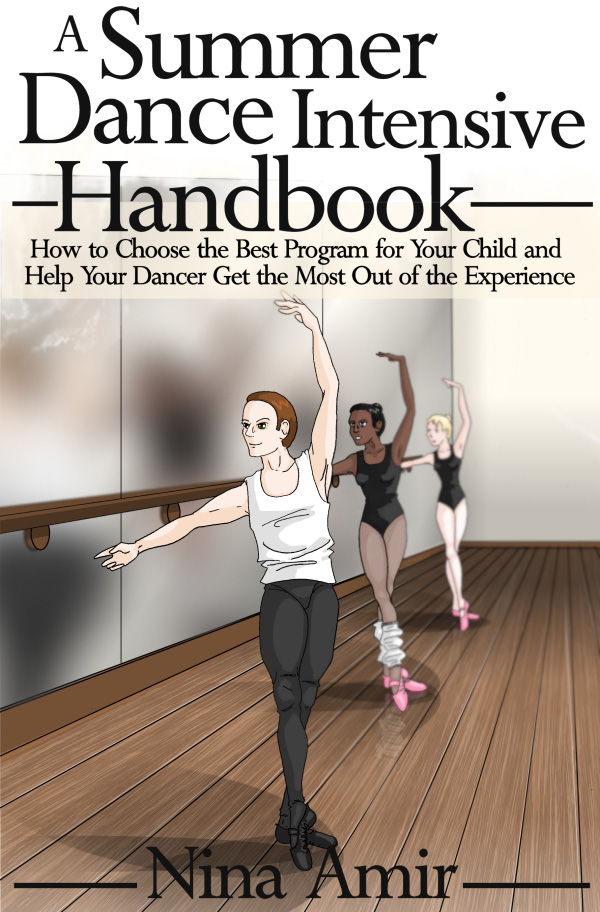There’s a lot to know about summer dance intensives, and both students and parents may have a lot of questions regarding topics such as which one to choose, what to do about housing and which intensives are the best match for their particular situation. And the biggest question of all may be where to find those answers…
Nina Amir is a journalist with a vested interest in the subject–she is also the parent of a dancer, and the author of “My Son Can Dance” – a popular dance blog on the web. She created a handbook that helps answer a lot of the basic questions people may have about summer intensives in the dance world. Today, we talk with her about that resource–and learn more about why she decided to write it…
 How did the idea for this handbook come about?
How did the idea for this handbook come about?
Every year I receive a ton of questions about summer dance intensives—especially about the American Ballet Theatre intensive in New York. From about November or December, when the boys and their parents start gearing up to audition for the bigger intensives, through until May or June, my readership at My Son Can Dance, skyrockets. Mostly these visitors are reading posts about summer intensives. It became obvious parents needed and wanted help not only deciding on an intensive but choosing the right one for their dancers—not just the dancin’ boys but the girls as well.
I’d written a number of blog posts on the topic of choosing and preparing for an intensive that I felt could be expanded into longer articles, if you will, or chapters. Also, I thought I would be doing the community a service by compiling some of the posts I’d written into one document—an easily read handbook—and adding more information as well.
What is covered in the handbook?
The Handbook includes chapters on:
- How to Choose a Summer Dance Intensive Program
- How to Register for a Summer Dance Intensive
- What to Bring to a Summer Dance Intensive
- How to Prepare for a Summer Dance Intensive
- How to Stay Healthy and Strong During a Summer Dance Intensive
- How Dancers Should Conduct Themselves During a Summer Dance Intensive
Plus, it has one full chapter on “What to Consider When Attending the ABT Summer Dance Intensive in New York City.”
The new edition, which I released the last week of January, includes a bit more information than before. I’ve updated it to include the experiences Julian and I had during our additional summers in New York while he was at ABT and Complexions Contemporary Ballet, and what we learned when he attended the School of American Ballet and San Francisco Ballet summer intensives. It also includes a brief discussion of how some of these programs can lead to year-round residential programs.
Can you give readers a few tips for summer intensives that you talk about in the handbook?
Housing is the big issue with ABT New York, since it is not provided by ABT. You really have to consider if your child is old enough and mature enough to go to New York City alone and live in a dorm (or if you are comfortable letting your dancer go alone). If he or she does, this means getting to and from the ABT studios alone.
It is true that the dancers from a variety of programs tend to be housed together in either NYU or New School dorms, which are easy walking distance to ABT, and they also do tend to have a buddy system when getting around the city. However, your dancer will need to prepare meals for himself or herself, do laundry, deal with injuries, etc.—alone. Unless…you tag along as a chaperone, which is a big commitment on your part and requires finding housing. If these housing issues seem too intimidating to you, opt for an ABT program at another location (like on a college campus), but know New York is their premier program.
When attending the School of American Ballet summer intensive, your child needs to realize he or she is going to a ballet program that is unlike any other. Balanchine is not like doing “normal” classical ballet. Your child could hate this style—or love it, as Julian did. At this program, your child can be in New York yet ensconced in the safety of the SAB building. They live, eat, dance in one building. In fact, they live in the Juilliard dorms and eat in the Juilliard/SAB cafeteria. They never have to go outside if they don’t want to.
San Francisco Ballet School offers a great program in a smaller city on the West Coast. For parents who feel uncomfortable about sending a child to New York, this is a nice option. (I could see Boston or Chicago also being good alternatives.) Although housing is provided, it is 45 minutes away unless you happen to be on the “watch list” for the trainee program. Then you will be just 15 minutes away in Jackson House. But everyone rides public transportation. The kids do not need to cook for themselves, unless they live in Jackson House. This program is tightly run, and is a great alternative, as are most of the other programs run by large companies, such as Boston Ballet, Pacific Northwest, and Houston Ballet.
A great alternative is a program on a college campus, such as some of those actually run by a college. Know that if your child attends a program run by a college and plans to apply to that college, this could hurt or help them during the application and audition process.
A great example of this is the Juilliard summer intensive. It is very small and hard to get into. However, once in you work with some of the same professors who you will study with—and who make the decisions about entry into the Juilliard college program. If they don’t like you during the summer…that’s bad news for you. If they do…it could be good news. Your child does get a chance to see if they like the educational environment and teachers while attending the intensive.
If your child is not ready for a large summer dance intensive, then simply start small. There are regional dance intensives that offer a variety of dance styles. Julian used to love attending these when he was younger. He could do tap, jazz, hip hop, ballet—everything.
Even if your dancer is ready to focus on ballet, you can choose a smaller program. Plus, there are a ton of programs out there—Ellison, Harid, The Rock, Ballet West…You can surely fine one that fits your child’s needs. Don’t feel your child must go to SAB, ABT or SFB to “make it” in the world of dance. In fact, some say that Ellison Ballet has a higher percentage of students who get professional jobs than most schools. So, go to the school that feels right to you and your dancer.
What can parents do to help prepare their child for a summer intensive?
It depends what type of intensive it is. If your child is attending a small regional intensive, then prepare him or her for longer days then normal. Most programs run from early in the morning until late in the afternoon. So, being in good shape is a necessity. Sometimes kids take had a few weeks or a month off before they start; big mistake! Make sure your child is in shape, even if they are swimming, jumping rope, or running.
Also prepare them to be a little intimidated by the new kids and the sense of competition or not being the “best” (if that’s what they are used to). Many dancers from small studios who have always been at the top of the class are surprised to find themselves at the bottom. This can rock their self-esteem unless they know what to expect.
Help your dancer understand the etiquette of being in larger classes. They don’t want to always be going last or standing at the back of the room. Nor do they want to be front and center at all times and annoying other dancers who are trying to get seen. Help them find their “place.”
Hydrate them prior to starting the intensive. Drinking Gatorade or some other drink with electrolytes is a good idea, but start increasing these types of fluids several days before the intensive and continue until it is over—especially in studios or climates that are hot.
Make sure your dancer eat lots of protein and takes vitamins. They need to feed their bodies necessary nutrients to dance for such long hours.
What do you think people are the most surprised to learn about regarding summer intensives?
I don’t know…maybe the hands-off attitude most of the really “elite” programs have about the parents. Unless you are at a small regional intensive, parents are not welcome. At ABT, for example, you are only allowed in the building once to watch class. You aren’t even supposed to call; they want you to email. If you’ve never even sent your child to sleep-away camp, this can be a shock.
The other thing might be how many injuries the dancers get at the summer ballet intensives. These programs are very rigorous. The first year, Julian could hardly move after the first week—and you couldn’t touch him without him saying it hurt. Every muscle was sore! By the end of week two, he was exhausted but not quite as sore. By week three, he was better. That’s about when things either go down hill or get better, though. Lots of kids get stress fractures, tendonitis and the like.
(Recently 4dancers ran a post on how to prepare for a summer intensive that has some great tips that can help you or your dancer avoid common causes of injury. Read it here.)

Nina Amir is a journalist and author currently writing a book meant to mentor young boys (age 10-17) who dream of becoming professional dancers.
She has a son, Julian, who has been dancing for eleven years and she realized what a difficult road it was for young male dancers early on in his career. Nina’s blog, My Son Can Dance, offers advice and tips for surviving the tough early years so young boys who want to dance will have the strength, inspiration and tools to do so. She also writes on a variety of other subjects. Learn more about her here.
More information about her summer intensive handbook can be found here.




